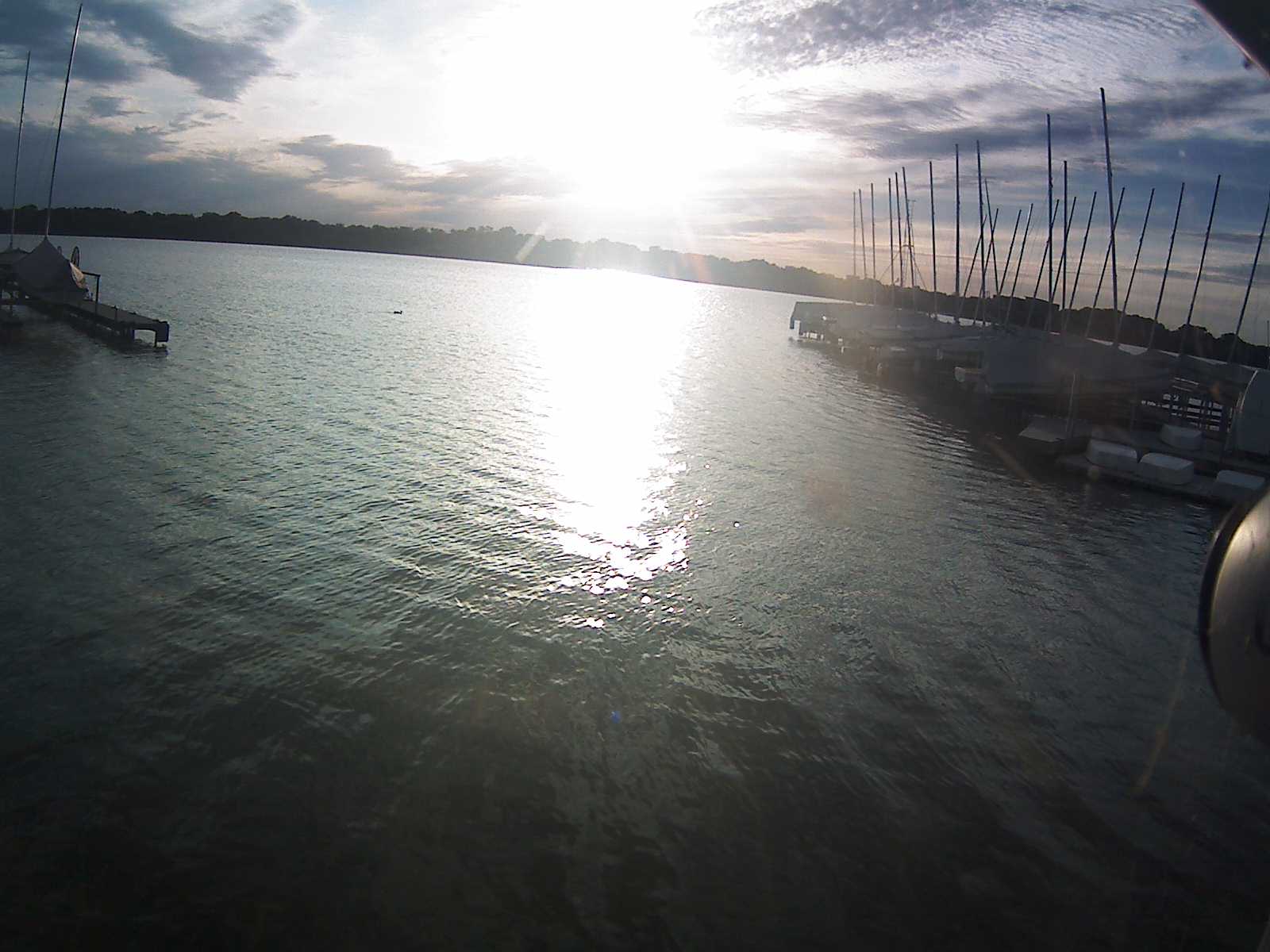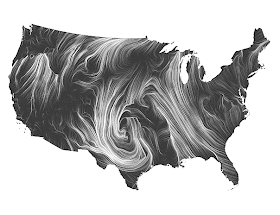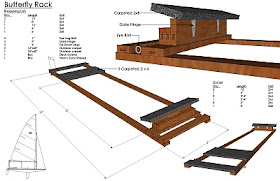DOWNWIND - PART 5: SPEED - SAILING BY THE LEE
at 11.18.2011
(c) 2011 Doug Peckover
Remember the days when you’d round the windward mark, bear off, let the sail out, and then relax? Everyone would take it easy and the competition would start again at the bottom of the course. Well, those days are gone forever because more than ever, races are won or lost going downwind. And with the phasing out of reaches, going fast downwind means going fast on a run. And going fast on a run means learning how to sail by the lee. It’s something I try to do on every part of every run.
But first, a review: why your mast is really bad. The diagram on the left shows the drag in red on a boat’s jib when going upwind. It’s hardly visible in the diagram because the forestay holding the jib creates minimal turbulence, so the jib has very little drag and has a whole lot of lift. This is one reason why jibs are so efficient. The diagram on the right is the main of a Butterfly or Laser and has much more turbulence because of the mast. So much so that the front part of a main does not work and that’s why the telltales on a main have to be placed well back from the mast to flow properly.
More reviewing: why flow across a sail is really good. Have you ever wondered why sailing on a broad reach is so much faster than sailing on a run? Or why an asymmetrical spinnaker is faster than a regular spinnaker? Or why a house roof that is low is more at risk in a hurricane than a high roof with steeper angles? The reason is that the wind creates a lot more lift when it goes across an object than when it’s just trapped by an object.
In a perfect world, your mast would not create turbulence on your sail and the wind would always flow across it. But this is not how we sail on a run. As shown in the next diagram, the boat on the left (a Butterfly or Laser) has its sail all the way out and is trapping lots of wind, creating lots of turbulent drag, and not generating lift. The drag is in the correct direction so the boat goes downwind, but it’s rather crude.
The boat on the right is sailing differently: it has born off past a run to the point of almost jibing, its sail is pulled in slightly, and the apparent wind is coming from the right (more on this below). In fact, the main looks and works a lot like a jib in the diagram above:
Sailing by the lee has awesome potential because the boat feels much livelier with all the extra lift. But the way you sail by the lee is completely different for a whole bunch of reasons:
- I like to play the main in and out slightly, feeling the different pressure. It goes from hardly any pressure and wanting to jibe to really powered up and driving forward. Timing this power properly is a great way to catch even small waves.
- The leading edge of the main is not at the mast but at the leach, so there is very little turbulent drag and tons of lift. But you have to learn how to control this because it changes suddenly.
- When you head up slightly and then bear off, the end of the boom torques to windward. This is a legal pump and is a fantastic way to catch more waves.
- I try to steer with my weight, so bearing off is leaning out to heel to windward. As a result, the end of my boom actually torques back and up at the same time. It feels like I’m “scooping” more pressure and, when timed properly, feels very fast.
- I like to set my vang so that the leach stretches and “breathes” backward and forward about 8 inches. This is a completely natural and legal pumping motion.
- In addition, you can use your mainsheet to pump the main once per wave. This is significant because you’re pumping the leading edge of the main, which is super effective because that’s where all of the lift comes from. This is the only time in sailing when you can pump the part of a sail that has all of the lift.
- And just like on a broad reach when the boat’s movement shifts the apparent wind forward onto a reach, sailing by the lee also moves the apparent wind forward, as shown in the above diagram. If done properly, the main is reaching while you’re going downwind on the opposite tack.
- With the increased feeling on the mainsheet, you’re much more aware of what the wind is doing. To help this, I have a wind indicator at the top of my mast so that I can see the wind angles. Looking up on a run, I start with the wind coming from behind (in red in the first picture). Bearing off, the wind shifts to being over my left shoulder (second picture) to sail by the lee. If the wind shifts to over my right shoulder (third picture), I jibe to be sailing by the lee again to get the wind flowing the other way across the mail (forth picture). This sailing has the advantage of making you much more aware of where the wind is coming from so you can see and play the shifts going downwind:
- In addition to being fast, sailing by the lee is more stable when it’s really windy because the boom is in more, so the top of the main is less likely to twist forward. This twisting is why when boats tip on a run in a gust, it’s almost always to windward.
- Finally, there was an idea suggested by my long-time friend Frank Bethwaite who theorized that there are three ways to use the wind: catching (like a spinnaker), deflecting (like a jib or main), and reusing the wind (like a hummingbird). You see, hummingbirds fly more efficiently by creating vortexes that can be reused. There are times when sailing by the lee definitely feels like this, but I haven’t completely perfected that.
Managing this orchestra of feelings is a little overwhelming at first and, if you’re practicing it correctly, you will jibe by mistake just when the pressure on your mainsheet is the most. But with practice, you’ll develop a definite rhythm that generates enough lift to more than make up for any extra distance that you sail.
This is great for boats like Lasers and Sunfish because you can let the sail out as far as needed, but what about boats that have side stays like Butterflys that restrict this movement? It’s best on these boats to let the vang off a little to get more twist in the sail and then bear off without jibing. But be careful if it’s windy because this twist will make everything less stable. It’s a hard skill to learn, so it will give the best sailors a definite advantage and something that everyone else can work on.
Sailing by the lee is a fantastic way to catch and pass boats downwind. It also gives you the lateral movement that you need to position yourself to catch the right puffs and stay in the pressure. How you do this is the subject of our next article.













12/30/2011 3:44 PM
Your comment re-using the wind (Humming bird): I have wind indicator at the bottom of the sail - on lee sailing I find the most power at the right sail angle results when this indicator spins in a vortex- could this be the extra power from re-using the wind?? Comments!!
12/30/2011 10:36 PM
Great observation! What you're seeing with your indicator at (I assume) the bottom of your mast is turbulence as the wind exits the sail, just like the vortex at the end of a 747's wing (and why they reduce this with winglet's). We know this is the exit because the flow is from the leach to the mast because you are sailing by the lee. As this is the exit, the wind cannot be reused.
The reusing I was referring to is the leading edge (the leach) pushing the wind back upwind so that it can be reused. It's hard to describe but you can definitely feel it on the mainsheet, especially sailing at night when there are fewer distractions. More work has to be done on this but it is worth exploring. Let me know if you can find it!
5/08/2015 7:31 PM
This is the FIRST explanation that has made any sense to me. I've looked at 6 or 8 'big-name' or magazine-sponsored web pages, and none of them made sense. Your not only makes sense of the 'how', but explains the benefits more clearly, and even ways to leverage the technique to even greater advantage. Fantastic!! I hope you don't mind if I save this web page to refer back to... Thanks very much! Greg